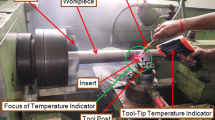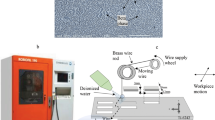Abstract
In this paper, possibility of improving high-speed reciprocating wire electrical discharge machine (HS-WEDM) machining performances using SiC nanofluids was studied. The performances of SiC nanofluid high-speed WEDM and conventional emulsion dielectric high-speed WEDM were compared. An extra dielectric circulating system was used to satisfy requirement of adding SiC nanofluids. Type of operation, dielectric medium combination, and pulse on time were taken as considerable process parameters of performance of average cutting speed (ACS), surface roughness (SR), surface morphology, recast layer thickness, and material transfer. The result showed that the SiC nanofluids dielectric medium gives a better surface quality and average cutting speed as compared to conventional emulsion dielectric. The average cutting speed increased from 16.9 to 21.22 mm2/min, surface roughness improved from 1.463 to 1.233 μm, and recast layer thickness reduced from 24.7 to 12.9 μm during the HS-WEDM multiple cutting process. The secondary discharge during SiC nanofluids multi-cutting process is the main reason for improvement of the surface quality. Furthermore, scanning electron microscope (SEM), energy dispersive spectroscopy (EDS), and X-ray diffraction (XRD) investigation revealed a substantial transform of carbon and silicon from SiC nanofluids to the workpiece surface.









Similar content being viewed by others
Data availability
All data generated or analyzed during this study are included in this published article.
References
Ho KH, Newman ST, Rahimifard S, Allen RD (2004) State of the art in wire electrical discharge machining (WEDM). Int J Mach Tools Manuf 44(12-13):1247–1259. https://doi.org/10.1016/j.ijmachtools.2004.04.017
Sharma V, Patel DS, Jain VK, Ramkumar J (2020) Wire electrochemical micromachining: an overview. Int J Mach Tools Manuf 155:103579. https://doi.org/10.1016/j.ijmachtools.2020.103579
Kuo C, Kao H, Wang H (2017) Novel design and characterisation of surface modification in wire electrical discharge machining using assisting electrodes. J Mater Process Technol 244:136–149. https://doi.org/10.1016/j.jmatprotec.2017.01.025
Wang J, Wang T, Wu H, Qiu F (2017) Experimental study on high-speed WEDM finishing in steam water mist. Int J Adv Manuf Technol 91(9-12):3285–3297. https://doi.org/10.1007/s00170-017-0005-y
Cao C, Zhang X, Zha X, Dong C (2014) Surface integrity of tool steels multi-cut by wire electrical discharge machining. Procedia Eng 81:1945–1951. https://doi.org/10.1016/j.proeng.2014.10.262
Wu H, Wang T, Wang J (2019) Research on discharge state detection of finishing in high-speed wire electrical discharge machine. Int J Adv Manuf Technol 103(5-8):2301–2317. https://doi.org/10.1007/s00170-019-03708-z
Wang W, Qiu M, Liu Z, Zhang M, Shao C (2020) Study on the influence of kerosene content on burn in high speed–wire cut electrical discharge machining dielectric fluid. Int J Adv Manuf Technol 107(7-8):3135–3143. https://doi.org/10.1007/s00170-020-05187-z
Ji Y, Liu Z, Deng C, Fang L, Qiu M (2018) Study on high-efficiency cutting of high-thickness workpiece with stranded wire electrode in high-speed wire electrical discharge machining. Int J Adv Manuf Technol 100(1-4):973–982. https://doi.org/10.1007/s00170-018-2745-8
Wang T, Lu YM, Qiu F, Xu XC (2010) Gas-liquid combined multiple cut for WEDM. Key Eng Mater 431-432:511–514. https://doi.org/10.4028/www.scientific.net/KEM.431-432.511
Wang T, Lu YM, Hao SS, Xie SQ, Xu XC, Wang Y (2008) Dry WEDM in improving HS-WEDMed surface quality. Key Eng Mater 392-394:624–628. https://doi.org/10.4028/www.scientific.net/KEM.392-394.624
Joshi AY, Joshi AY (2019) A systematic review on powder mixed electrical discharge machining. Heliyon 5(12):e02963. https://doi.org/10.1016/j.heliyon.2019.e02963
Abdudeen A, Abu Qudeiri JE, Kareem A, Ahammed T, Ziout A (2020) Recent advances and perceptive insights into powder-mixed dielectric fluid of EDM. Micromachines 11(8):754–778. https://doi.org/10.3390/mi11080754
Shabgard MR, Gholipoor A, Baseri H (2016) A review on recent developments in machining methods based on electrical discharge phenomena. Int J Adv Manuf Technol 87(5-8):2081–2097. https://doi.org/10.1007/s00170-016-8554-z
Hourmand M, Sarhan AAD, Farahany S, Sayuti M (2018) Microstructure characterization and maximization of the material removal rate in nano-powder mixed EDM of Al-Mg2Si metal matrix composite—ANFIS and RSM approaches. Int J Adv Manuf Technol 101(9-12):2723–2737. https://doi.org/10.1007/s00170-018-3130-3
Kumar A, Mandal A, Dixit AR, Das AK, Kumar S, Ranjan R (2018) Comparison in the performance of EDM and NPMEDM using Al2O3 nanopowder as an impurity in DI water dielectric. Int J Adv Manuf Technol 100(5-8):1327–1339. https://doi.org/10.1007/s00170-018-3126-z
Kumar H (2014) Development of mirror like surface characteristics using nano powder mixed electric discharge machining (NPMEDM). Int J Adv Manuf Technol 76(1-4):105–113. https://doi.org/10.1007/s00170-014-5965-6
Öpöz TT, Yaşar H, Ekmekci N, Ekmekci B (2018) Particle migration and surface modification on Ti6Al4V in SiC powder mixed electrical discharge machining. J Manuf Process 31:744–758. https://doi.org/10.1016/j.jmapro.2018.01.002
Talla G, Gangopadhayay S, Biswas CK (2016) State of the art in powder-mixed electric discharge machining: a review. Proc Inst Mech Eng B J Eng Manuf 231(14):2511–2526. https://doi.org/10.1177/0954405416634265
Haddad Z, Abid C, Oztop HF, Mataoui A (2014) A review on how the researchers prepare their nanofluids. Int J Therm Sci 76:168–189. https://doi.org/10.1016/j.ijthermalsci.2013.08.010
Bahiraei M, Heshmatian S (2019) Graphene family nanofluids: a critical review and future research directions. Energy Convers Manag 196:1222–1256. https://doi.org/10.1016/j.enconman.2019.06.076
Sajid MU, Ali HM (2018) Thermal conductivity of hybrid nanofluids: a critical review. Int J Heat Mass Transf 126:211–234. https://doi.org/10.1016/j.ijheatmasstransfer.2018.05.021
Paswan K, Pramanik A, Chattopadhyaya S (2020) Machining performance of Inconel 718 using graphene nanofluid in EDM. Mater Manuf Process 35(1):33–42. https://doi.org/10.1080/10426914.2020.1711924
Garg RK, Singh KK, Sachdeva A, Sharma VS, Ojha K, Singh S (2010) Review of research work in sinking EDM and WEDM on metal matrix composite materials. Int J Adv Manuf Technol 50(5-8):611–624. https://doi.org/10.1007/s00170-010-2534-5
Kumar V, Sharma N, Kumar K, Khanna R (2017) Surface modification of WC-Co alloy using Al and Si powder through WEDM: a thermal erosion process. Part Sci Technol 36(7):878–886. https://doi.org/10.1080/02726351.2017.1317308
Sivaprakasam P, Hariharan P, Gowri S (2019) Experimental investigations on nano powder mixed micro-Wire EDM process of inconel-718 alloy. Measurement 147:106844. https://doi.org/10.1016/j.measurement.2019.07.072
Murshed SMS, Leong KC, Yang C (2008) Thermophysical and electrokinetic properties of nanofluids – a critical review. Appl Therm Eng 28(17-18):2109–2125. https://doi.org/10.1016/j.applthermaleng.2008.01.005
Huminic G, Huminic A, Fleaca C, Dumitrache F, Morjan I (2017) Thermo-physical properties of water based SiC nanofluids for heat transfer applications. Int Commun Heat Mass Transf 84:94–101. https://doi.org/10.1016/j.icheatmasstransfer.2017.04.006
Klocke F, Lung D, Antonoglou G, Thomaidis D (2004) The effects of powder suspended dielectrics on the thermal influenced zone by electrodischarge machining with small discharge energies. J Mater Process Technol 149(1-3):191–197. https://doi.org/10.1016/j.jmatprotec.2003.10.036
Deng C, Liu Z, Zhang M, Ji Y, Pan H (2019) Minimizing drum-shaped inaccuracy in high-speed wire electrical discharge machining after multiple cuts. Int J Adv Manuf Technol 102(1-4):241–251. https://doi.org/10.1007/s00170-018-3068-5
Janmanee P, Muttamara A (2012) Surface modification of tungsten carbide by electrical discharge coating (EDC) using a titanium powder suspension. Appl Surf Sci 258(19):7255–7265. https://doi.org/10.1016/j.apsusc.2012.03.054
Kumar S, Batra U (2012) Surface modification of die steel materials by EDM method using tungsten powder-mixed dielectric. J Manuf Process 14(1):35–40. https://doi.org/10.1016/j.jmapro.2011.09.002
Kumar S, Singh R, Singh TP, Sethi BL (2009) Surface modification by electrical discharge machining: A review. J Mater Process Technol 209(8):3675–3687. https://doi.org/10.1016/j.jmatprotec.2008.09.032
Algodi SJ, Clare AT, Brown PD (2018) Modelling of single spark interactions during electrical discharge coating. J Mater Process Technol 252:760–772. https://doi.org/10.1016/j.jmatprotec.2017.10.029
Ekmekci B, Yaşar H, Ekmekci N (2016) A discharge separation model for powder mixed electrical discharge machining. J Manuf Sci Eng 138(8):081006-1-081006-9. https://doi.org/10.1115/1.4033042
Ekmekci N, Ekmekci B (2015) Electrical discharge machining of Ti6Al4V in hydroxyapatite powder mixed dielectric liquid. Mater Manuf Process 31(13):1663–1670. https://doi.org/10.1080/10426914.2015.1090591
Luzia CAO, Laurindo CAH, Soares PC, Torres RD, Mendes LA, Amorim FL (2019) Recast layer mechanical properties of tool steel after electrical discharge machining with silicon powder in the dielectric. Int J Adv Manuf Technol 103(1-4):15–28. https://doi.org/10.1007/s00170-019-03549-w
Jabbaripour B, Sadeghi MH, Shabgard MR, Faraji H (2013) Investigating surface roughness, material removal rate and corrosion resistance in PMEDM of γ-TiAl intermetallic. J Manuf Process 15(1):56–68. https://doi.org/10.1016/j.jmapro.2012.09.016
Kumar Sahu S, Dey B, Datta S (2019) Selection of appropriate powder-mixed dielectric media (kerosene and used transformer oil) for desired EDM performance on Inconel 718 super alloys. Mater Today Proc 18:4111–4119. https://doi.org/10.1016/j.matpr.2019.07.355
Funding
This study was supported in part by grants from the National Natural Science Foundation of China (51165012).
Author information
Authors and Affiliations
Contributions
Cuixia Guo: Methodology, validation, data curation, writing - original draft
Zhangyong Wu: Formal analysis, investigation, conceptualization, resources, methodology, supervision
Xing Wang: review and editing
Jingping Zhang: writing - review and editing
Corresponding author
Ethics declarations
Ethical approval
Not applicable.
Consent to participate
Written informed consent was obtained from individual or guardian participants.
Consent to publish
Not applicable.
Competing interests
The authors declare no competing interests.
Additional information
Publisher’s note
Springer Nature remains neutral with regard to jurisdictional claims in published maps and institutional affiliations.
Rights and permissions
About this article
Cite this article
Guo, C., Wu, Z., Wang, X. et al. Comparison in performance by emulsion and SiC nanofluids HS-WEDM multi-cutting process. Int J Adv Manuf Technol 116, 3315–3324 (2021). https://doi.org/10.1007/s00170-021-07600-7
Received:
Accepted:
Published:
Issue Date:
DOI: https://doi.org/10.1007/s00170-021-07600-7




